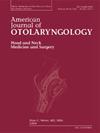系统性免疫炎症指数联合eb病毒DNA预测鼻咽癌预后的回顾性研究
IF 1.8
4区 医学
Q2 OTORHINOLARYNGOLOGY
引用次数: 0
摘要
背景:癌症一直是世界范围内死亡的主要原因,头颈癌(HNC)是癌症相关死亡的十大原因之一。特别是鼻咽癌,是一种东亚特有的癌症。大量研究表明,eb病毒(EBV) DNA载量和全身免疫炎症(SII)指数可作为鼻咽癌患者的预后指标。然而,没有研究比较不同的炎症因子预测模型。本研究结合I至IV期鼻咽癌患者的SII和EBV病毒载量,并比较不同的炎症因子模型,以确定最佳预测模型。材料和方法:我们回顾了2016年1月至2023年7月诊断的240例I至IV期NPC患者。我们收集了诊断为鼻咽癌的成年患者的数据,包括那些在本分析中完成最终分期检查和治疗的患者。我们通过Cox回归测试了各种炎症标志物和EBV DNA负荷,以进行生存分析。结果:EBV病毒载量、SII和SIRI与鼻咽癌的严重程度相关。在单因素Cox回归分析中,临床分期、EBV病毒载量(HR: 2.15, 95% CI: 1.19-3.90)、NLR(2.37, 1.29-4.34)、PLR(2.7, 1.06-6.87)、SIRI(2.02, 1.11-3.68)和SII(2.45, 1.51 -4.89)是影响总生存的预后因素。在多因素分析中,在调整性别、年龄和临床分期后,EBV病毒载量和SII较高与预后较差相关(HR: 4.71, 1.95-11.41)。结论:EBV病毒载量与SII结合可较好地预测鼻咽癌的预后。本文章由计算机程序翻译,如有差异,请以英文原文为准。
Systemic immune inflammation index combined with Epstein–Barr virus DNA for predicting the prognosis of nasopharyngeal carcinoma: A retrospective study
Background
Cancer has consistently been the leading cause of death worldwide, with head and neck cancer (HNC) being one of the top ten causes of cancer-related death. Nasopharyngeal carcinoma (NPC), in particular, is a cancer that is unique to East Asia. Numerous studies have shown that the Epstein–Barr virus (EBV) DNA load and the systemic immune inflammation (SII) index can serve as prognostic indicators for NPC patients. However, no studies have compared different predictive models of inflammatory factors. This study combines the SII and the EBV virus load in patients with stage I to IV NPC and compares different inflammatory factor models to determine the best predictive model.
Materials and methods
We reviewed 240 patients with stage I to IV NPC who were diagnosed between January 2016 and July 2023. We collected data from adult patients who were diagnosed with NPC and included those who completed the definitive staging workup and treatment in this analysis. We tested various inflammatory markers and the EBV DNA load via Cox regression for survival analysis.
Results
We found that the EBV viral load, the SII, and the SIRI are related to the severity of nasopharyngeal cancer. In the univariate Cox regression analysis, clinical stage, EBV virus load (HR: 2.15, 95 % CI: 1.19–3.90), NLR (2.37, 1.29–4.34), PLR (2.7, 1.06–6.87), SIRI (2.02, 1.11–3.68), and SII (2.45, 1.251–4.89) were prognostic factors for overall survival. In the multivariate analysis, after adjusting for sex, age and clinical stage, a higher EBV virus load and SII were associated with a worse prognosis (HR: 4.71, 1.95–11.41).
Conclusion
The combination of the EBV viral load and the SII was a better predictor of NPC prognosis.
求助全文
通过发布文献求助,成功后即可免费获取论文全文。
去求助
来源期刊

American Journal of Otolaryngology
医学-耳鼻喉科学
CiteScore
4.40
自引率
4.00%
发文量
378
审稿时长
41 days
期刊介绍:
Be fully informed about developments in otology, neurotology, audiology, rhinology, allergy, laryngology, speech science, bronchoesophagology, facial plastic surgery, and head and neck surgery. Featured sections include original contributions, grand rounds, current reviews, case reports and socioeconomics.
 求助内容:
求助内容: 应助结果提醒方式:
应助结果提醒方式:


